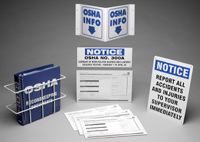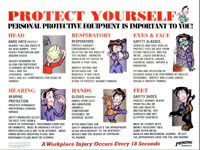 |
 |
| MSDS Topics |
Free Sites | FAQ's | Regulations | Glossary | Software | Suppliers |
| Books | Forum | Poll | Fun stuff | Quiz | Store | |
| MSDS and safety supplies | Search ALL our MSDS info | |||||
 | |||
 |
 |
 |
|
| Title: 04/30/1996 - Information on temporary workers, particularly those in the electronic assembly industry. | |
| Record Type: Interpretation | Standard Number: 1926.20; 1926.21; 1910.1200; 1926.59 |
April 30, 1996
[Name Withheld]
Dear [Name Withheld]:
This is the third and last response to your letter of November 13, 1995, in which you requested information on temporary workers, particularly those in the electronic assembly industry and office workers like Kelly Services. This letter will address your questions #1, 7, 11, and 12.
Please keep in mind that these situations are very heavily fact-based, much of the interpretation depends upon the specific facts and circumstances of a particular situation and workplace.
The employees who work through employment agencies are generally called "temporary," "leased," or "supplied" workers (referred to in this letter as temporary workers). These employees are supplied by a "temporary," "leasing," or "supplying" employment agency who is their employer (referred to in this letter as temporary agency employer). This employer enters into contracts with secondary employers generally called the "host" or "client" employer (referred to in this letter as host employer).
Question #1. Whose safety program covers temporary workers? Should it be the responsibility of the temporary agency/supply employer to establish the systems for accident investigation, hazard identification, training, safety rule enforcement, etc.? We recognize this can only be effective by communications with the host employer regarding the specific tasks, work environment, etc.
|  Workplaces with 11 or more employees have to comply with OSHA 300 work-related injury reporting requirements. Get your compliance materials at Safety Emporium. |
Question #7. Would excluding temporary workers from various safety incentive programs present concerns to OSHA?
 Ensure that your MSDS collection is "readily accessible" with these handy compliance centers from Safety Emporium.
|
Employer Interference. Where entry has been allowed but the employer interferes with or limits any important aspect of the inspection, the CSHO shall determine whether or not to consider this action as a refusal. Examples of interference are refusals to permit the walkaround, the examination of records essential to the inspection, the taking of essential photographs and/or videotapes, the inspection of a particular part of the premises, indispensable employee interviews, or the refusal to allow attachment of sample devices. [emphasis added]
|
Question #12. How is the employer-employee relationship defined by OSHA when temporary workers are utilized in the workplace? Is there any guidance provided in the OSHA compliance directives or field manual?
Definition of Employee. Whether or not exposed persons are employees of an employer depends on several factors, the most important of which is who controls the manner in which the employees perform their assigned work. The question of who pays these employees may not be the determining factor. Determining the employer of an exposed person may be a very complex question, in which case the Area Director may seek the advice of the Regional Solicitor.
Two U.S. Supreme Court cases (neither case involved occupational safety and health), that discuss the criteria to be considered in determining the existence of a master-servant (or employer-employee) relationship in common law, are Nationwide Mutual Insurance Company v. Darden, 503 U.S. 318, 112 S.Ct. 1344, 117 L.Ed 2d 581 (1992) and Community for Creative Non-Violence v. Reid, 490 U.S. 730, 109 S.Ct. 2166 (1989). The cases held that the following criteria is to be considered in determining whether there is an employer-employee relationship.
|  Safety posters are a terrific way of reminding employees of proper procedure. Get yours at Safety Emporium. |
Sincerely,
Raymond Donnelly, Director
Office of General Industry
Compliance Assistance
The official, public domain, OSHA version of this document is available at http://www.osha.gov/pls/oshaweb/owadisp.show_document?p_table=INTERPRETATIONS&p_id=22156&p_text_version=FALSE